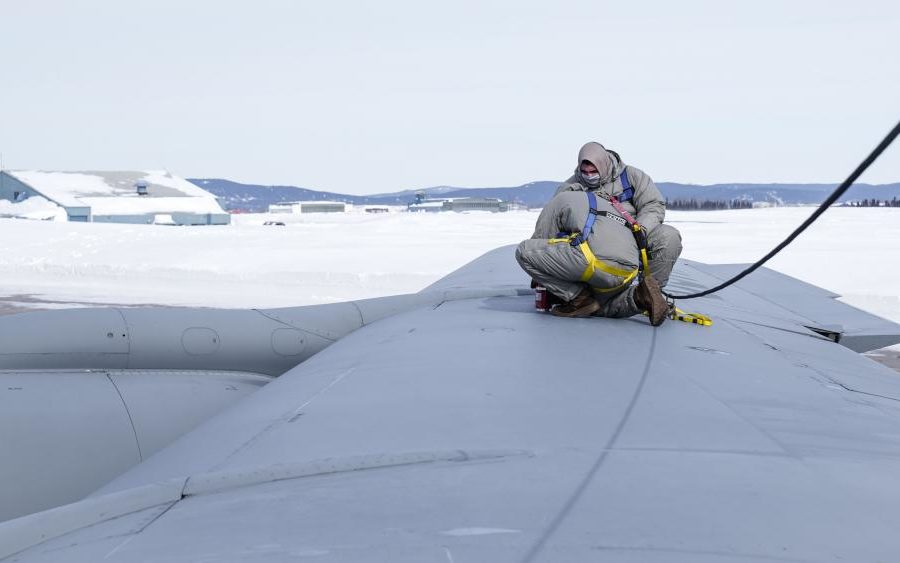U.S. Northern Command boss Gen. Glen D. VanHerck, who has pushed for the Pentagon to allocate more resources to the Arctic region in its annual budget, hopes to see a “significant” funding boost for domain awareness in 2023.
Speaking before the Senate Armed Services Committee on March 24, just four days before the 2023 budget request is released, VanHerck fielded plenty of questions from lawmakers concerned about the Arctic, a region of increasing importance where the melting ice cap, natural resources, and shipping lanes are all contested by the U.S., Russia, and even China, among other nations.
In June 2021, VanHerck told the Congressional panel that the budget only “inched” progress forward in the region, adding that “we didn’t move the ball very far down the field this year in the budget with regards to resources in the Arctic.”
Nine months later, his concerns about investments remain.
“We have not seen the funding that I would like to see with regards to the Arctic,” VanHerck told Sen. Dan Sullivan (R-Alaska).
Sullivan then noted, as VanHerck also has, that the services are at least paying more attention to the region—the Army, Navy, Marine Corps, and Department of the Air Force have all released strategic plans for the Arctic, some for the very first time, in the past few years.
But thus far, the money hasn’t matched those strategies, Sullivan and VanHerck said.
“I look forward to seeing the ‘23 budget,” VanHerck said. “The Arctic is strategic in nature. We must be persistent there to compete. That’s a part of … integrated deterrence.”
The Pentagon will rollout the fiscal 2023 budget request on March 28, and VanHerck indicated he hadn’t yet seen what it entails for the Arctic.
“Without seeing the ‘23 budget, I really can’t give you a full assessment of what we’re going to see for infrastructure support. I believe we will see additional domain awareness capabilities significantly funded with the ‘23 budget, but I look forward to seeing that,” VanHerck said. “I would assess that there may still be some work to do with regards to the strategies that each of the services have … put out, and the department strategy. But when the budget comes out, I’ll give you the final assessment.”
Domain awareness in the Arctic has been a stated priority for DOD for several years now. Billy Mitchell famously said that, “Alaska is the most central place in the world for aircraft operations.” It is closer to China than Hawaii, where Pacific Air Forces is headquarters is located, and when the ice freezes over in the winter, there are places where you can actually walk from U.S. to Russian territory.
But operating in the Arctic is always a challenge due to the harsh conditions and relative lack of infrastructure. There are actually more roads in the state of New Jersey, than there are in all of Alaska, even though if if placed Alaska on a map of the lower 48 it would stretch from Jacksonville, Fla., to San Francisco, Lt. Gen. David A. Krumm, the most senior military officer in Alaska, told Air Force Magazine.
Infrastructure is one area where VanHerck sees a need for investment, so the U.S. can continue to be a persistent presence in the region.
“We do need a presence, and fuel north of Dutch Harbor would do that, as would infrastructure and communications capabilities,” VanHerck said. “I look forward to working with the Canadians on their part of this. They need to be part of it as well, not only the Department of Defense, especially on the infrastructure piece.”
Both Russia and China, which is not technically an Arctic nation, have become increasingly aggressive in asserting their presence in the region.
“The Chinese are active in the Arctic,” VanHerck told lawmakers. “Each of the last five years, they’ve sent a vessel under the guise of a research vessel into the Arctic for military purposes, we assess. … And so they’re there. They’re influencing nations, they want to change and influence international norms and behavior as well.”
There is also the threat that Russia and China could pose by launching a missile to fly over the region to strike the U.S. In such a crisis, Sen. Angus King (I-Maine) pressed VanHerck on how he would coordinate with other combatant commands.
“I’m comfortable with the way the unified campaign plan is currently laid out. We have outstanding relationships with Canada, outstanding relationships with [U.S. European Command] and [U.S. Indo-Pacific Command]. I do think we need to look at, based on threat changes, how we would command and control those capabilities,” VanHerck replied.
“The threats to the homeland today do not reside in my area of responsibility. They are actually existing in other areas of responsibility, such as the INDOPACOM area of responsibility and the EUCOM area of responsibility. So I do think there’s potential gaps and seams that we need to make sure that we close those in a time of crisis and conflict to ensure we don’t have challenges that were unaccounted for.”
